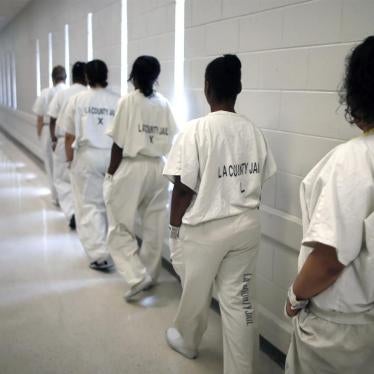The accounts from people inside Ohio’s Marion Correctional Institute expressed an overwhelming fear. In early April, as COVID-19 rapidly spread, they described living in dormitories with well over a hundred other men, double their capacity, in stacked bunks less than 3 feet apart.
Prison staff were not wearing masks or taking other precautions. They lacked cleaning equipment, fresh clothes, soap and clean masks. They said that staff ignored people who said they were sick or placed them in punitive solitary confinement. Meanwhile, more and more of the people in prison were experiencing extreme symptoms. Like in a horror movie, people would leave and not come back.
As a researcher on the criminal legal system for a human rights organization, I had grave concerns about the spread of COVID-19 in jails and prisons. The accounts from MCI confirm those concerns.
By April 20, MCI had over 1,800 known cases — 73% of those incarcerated. Ohio prisons accounted for 20% of the state’s COVID-19 cases. Due to the MCI outbreak, Marion County had the second highest infection rate of any U.S. county. The surrounding town has experienced a substantial number of cases, about half of them prison staff or people directly linked to them. Prisons and their surrounding communities are tightly connected. Staff members enter and leave daily, risking bringing infection in and carrying it out.
Though there had been two COVID-19 deaths at MCI by April 20, three weeks later 13 incarcerated people and one staff member had died. Ohio’s Pickaway Correctional Institution also has followed this rapid trajectory, with an even higher death toll. By May 11, there were 27 confirmed COVID-19 deaths of incarcerated people, and two more suspected. Reports from Pickaway indicate that as the pandemic was gaining steam, officials might not have been taking proper precautions, similar to conditions described in MCI.
Ohio has by far the highest rate of confirmed COVID-19 cases among people in its prisons of any state, and the highest total numbers, at 4,400, as of May 15. Arkansas and Michigan have the next highest numbers relative to their prison populations. These high rates might indicate a much wider problem as many states have conducted limited testing. The death count is rising.
Like Ohio, Michigan has had growing outbreaks in its prisons. By May 8 there had been 49 deaths, with 2,090 confirmed cases. Nearly half of people tested in Michigan prisons had COVID-19. In Arkansas, one prison reported that over half of its 1,200 incarcerated people tested positive — one-third of the state’s total COVID-19 cases. A lawsuit filed by civil rights organizations on behalf of people in that prison alleges that beds are too close together and people lack adequate protective gear.
These outbreaks are predictable. A recent study modeling COVID-19 transmission within immigration detention centers, similar to prisons, projected that 72% of those locked up would be infected with COVID-19 90 days after a center had five infected cases.
After the outbreak became national news, people imprisoned in MCI described some limited efforts to screen people, allow social distancing and separate those who tested negative from those who had the virus. But they also described watching their dorm-mates fight extreme illness, finding sick people lying on the floors and battling their own symptoms. They described a sense that their lives were not valued.
Ohio’s prisons, with an overall capacity of less than 40,000, held about 50,000 people on Dec. 31, 2018, the most recent date for which data is available. That population has tripled since 1980, reflecting the rise of mass incarceration throughout the United States. The vast racial disparity in who is imprisoned reflects the national situation. Black people in Ohio are incarcerated in jails and prisons at a rate five times greater than white people. Available data indicates black people are experiencing disproportionately high infection and death rates in the United States.
To provide some protection to people in prisons and to help stop the spread of COVID-19 inside prisons and in surrounding communities, medical experts we consulted recommend that officials should release people in sufficient numbers so that those remaining can effectively practice social distancing, while allowing nonpunitive isolation and quarantine for individuals who are infected or have had close contact with those infected, and providing proper medical care for those in need. But as of April 25, Ohio Gov. Mike DeWine had recommended release for only 300 people.
Officials throughout the United States should learn the dire lessons MCI teaches. The fear people incarcerated there expressed was real. Without decisive action, including large-scale reduction of prison populations, the deadly virus will spread uncontrollably. Even prisons that have not yet had major outbreaks remain at great risk. The time for decisive action is now.










